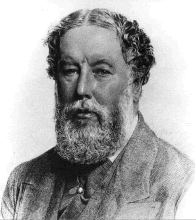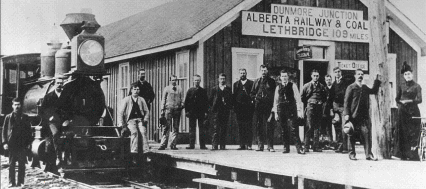
The initial group of financial supporters gathered by Sir Alexander Galt for the N.W.C.&N.Co. was made up of some powerful men. The group included the wealthy William H. Smith, owner of the well-known news agency and book-selling firm W.H. Smith & Sons. Another member was William Ashmead Bartlett Burdett-Coutts, a wealthy American married to Baroness Angela Burdett-Coutts (the richest heiress in England) . William Lethbridge, another high profile member, became the company's first president. These three men, the Galts, and other investors from Canada and Great Britain became the basis of a company that would make Lethbridge a major settlement in southern Alberta.

P19652008000-GM William Lethbridge, the namesake of the city of Lethbridge.
The N.W.C.&N.Co. started commercial drift mining in 1882. However, the problem of getting the coal to market hindered production and profits. The Coal Banks site was situated more than 175 kilometres from the proposed CPR mainline, and any solution would require a large investment in an efficient means of transportation. The problem became evident in the first year of operations when the company mines produced only 20 000 tonnes of coal because the only accessible buyers were at Fort Macleod.
The Galts then decided to transport the coal by river steamer down the Oldman and South Saskatchewan Rivers to the CPR main line at Dunmore, near Medicine Hat. When this proved to be inefficient, they applied for a government subsidy to build a smaller or "narrow gauge" railway from Coalbanks to Dunmore. The government was eager to see development in the West and thus granted the N.W.C.&N.Co. a precedent-setting land subsidy of 965 hectares per kilometre of railway. It also sold the company 4050 hectares of coal lands for $25 each. With these subsidies, the Galts began construction on the narrow gauge line in the fall of 1884 and on August 25, 1885 the first train rolled into Coalbanks.

P19694968000-GP Dunmore Junction, this was the first station along the line to Lethbridge. The line was built to transport Galt Coal to the CPR main line.
With a secure means of transportation, the N.W.C.&N.Co. began full production and recruited miners from across the continent. The mining camp boomed, and the company surveyed a new town site above the river valley. Sixty buildings were completed in just a few months. The new community was officially named Lethbridge (after William Lethbridge, the first president of the N.W.C.&N.Co.) on October 15, 1885 and was incorporated as a town five years later on December 29, 1890.
Previous Page | Exhibit Contents | Home | Navigation Information | Glossary | Curriculum Guide | Next Page
Copyright © 1996 Sir Alexander Galt Museum. All rights reserved.